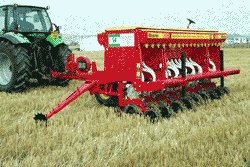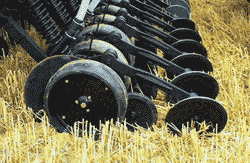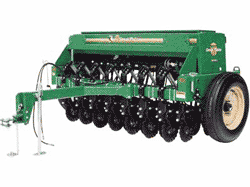Getting the right no-till drill for the job

Committing to no-till seeding across 1215ha (3000 acres) of combinable crops calls for a lot of faith in the technique – and finding the right drill for the job. Peter Hill reports
What is the ideal drill for no-till crop establishment? It depends what you want it to do, says Tony Reynolds, who will run three different seeders to establish cereal and break crops without cultivations this autumn.
Mr Reynolds and son-in-law Clive Patrick have committed wholeheartedly to a technique that many growers avoid like the plague. After five years rolling it out across farms in Lincolnshire and Leicestershire, 100% of their cereals and oilseeds will be established direct into the previous crops’ untouched residues.
“It’s been a pretty brutal leap into the unknown and the early years were very difficult,” says Mr Reynolds. “You have to get over the fact that your crops look pretty scruffy at emergence and hold firm in the face of a significant yield penalty from the first three or four years’ cropping.
“But the rewards, in terms of the impact on machinery and labour costs, fuel usage, soil structure and organic matter content should make it worth the worry,” he adds.
The radical switch to no-till establishment was triggered by a determination to invigorate lifeless soils previously ploughed and cultivated conventionally by improving long-term fertility and increasing organic matter. Finding the right drill has been among the challenges.
 |
|---|
| Tony Reynolds reckons the Bertini 22.000 no-till drill – in this case being demonstrated with optional pneumatic seeding units – is accurate and works well in dry conditions. But lack of clearance makes life difficult in sticky conditions. |
“At first, we paid for extended demonstrations of five different drills over the course of a couple of years to get some experience of the technique and the equipment,” says Tony Reynolds. “Then, having decided we were going all-out for no-till, we started out by purchasing a 4m Bertini 22.000 and a 6m John Deere 750A. This year, we’re adding a 3m Great Plains seeder to the fleet.”
Using a mixed fleet means the particular characteristics and design features of each drill can be used to best effect on different soil types and soil conditions.
“The Bertini is a very accurate drill, with an upright disc cutting through any surface trash ahead of a twin disc opener and with two angled steel press wheels closing the slot,” explains Mr Reynolds. “In the dry it’s brilliant, but there’s a lot of metal and little clearance under the machine, so in sticky conditions it tends to struggle.”
This machine’s chief role is at the farming operation’s 250ha (610-acre) Bourne operation in Lincolnshire, on soils ranging from black fen peat to heavy clay. Its particular strength is the ability to close the seed slot successfully on land not long in the no-till regime and therefore lacking the friable surface of longer-term no-till fields.
 |
|---|
| John Deere 750A NoTill seeder flies along but has some difficulty closing the seed slot effectively unless the soils are nicely friable, says Tony Reynolds. |
“Soil condition changes as the structure benefits from not being ploughed or run on repeatedly with cultivation implements,” says Mr Reynolds. “The soil becomes more friable and easier to drill but early in the process you need a drill that will close the slot properly so you don’t end up just feeding slugs.”
Although the John Deere 750A’s layout provides better trash and soil clearance, slot closing performance is not as good, in Mr Reynolds’ experience.
“That’s why we intend using it only in fields where we have good soil conditions,” he says. “Then it will fly along, covering up to 40ha (100 acres) a day.”
Being the larger of the two seeders, the 750A NoTill will tackle the bulk of the workload, supported on the heavier soils of the 1000ha (2500-acre) Melton Mowbray unit in Leicestershire by the Great Plains drill, which has been chosen to tackle the most challenging soils on this farm.
 |
|---|
| The Great Plains No-Till drill being added to the seeder armoury this autumn is expected to cope better with heavy soils thanks to the aggressive fluted cutting disc. |
“It has a more aggressive cutting disc ahead of the openers, which we think should help it cope better than the other two seeders in this situation,” says Mr Reynolds. “We really wanted a 6m unit to get the output but the 3m was all that was available for delivery in time.”
Buying a Shelbourne Reynolds stripper header for the combine has been another major investment to help exploit the no-till technique to the full. Instead of cutting through the stem to remove the ears, it combs the crop to leave the straw still anchored to the ground.
“Previously, we’d been cutting as high as we could to minimise the amount of straw being chopped and spread in the path of the drill disc openers,” Mr Reynolds explains. “But we think using the Stripper will be a better way to leave as clean a surface as possible.”
About 100ha (250 acres) of wheat were successfully harvested this way towards the end of last year’s campaign.
“We then drilled oilseed rape straight into the standing straw without difficulty,” Mr Reynolds reports. “What’s more, it helped keep the pigeons off, which was a bonus, and we ended up with some fantastic stands which, fingers crossed, will yield well.”
- Tony Reynolds is Farmers Weekly’s Midlands Barometer farmer. Read more about his adoption of no-till crop establishment here.

